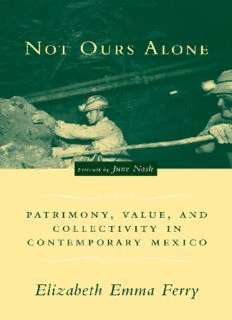
Not Ours Alone: Patrimony, Value, and Collectivity in Contemporary Mexico PDF
Preview Not Ours Alone: Patrimony, Value, and Collectivity in Contemporary Mexico
Not Ours Alone Not Ours Alone Patrimony,Value,and Collectivity in Contemporary Mexico Elizabeth Emma Ferry columbia university press new york columbia university press Publishers Since 1893 new york, chichester, west sussex Copyright © 2005Columbia University Press All rights reserved Library of Congress Cataloging-in-Publication Data Ferry,Elizabeth Emma. Not ours alone :patrimony,value,and collectivity in contemporary Mexico / Elizabeth Emma Ferry. p.cm. Includes bibliographical references and index. ISBN 0-231-13238-7(cloth :alk.paper) — ISBN 0-231-13239-5(pbk.:alk.paper) 1.Miners—Mexico—Guanajuato (State) 2.Guanajuato (Mexico :State)—Social conditions.3.Cooperative societies—Mexico—Guanajuato (State)—History.4.Cooperativa Minera Santa Fe de Guanajuato—History.5.Mineral industries—Mexico—Guanajuato (State)—History.6.Silver mines and mining—Mexico—Guanajuato (State)—History.7. Globalization. I.Title. HD9506.M63G8327 2005 334′.68232423′097241—dc22 2005045453 Casebound editions of Columbia University Press books are printed on permanent and durable acid-free paper. Printed in the United States of America c 10987654321 p 10987654321 To my parents,Anne and David Ferry contents foreword by june nash ix acknowledgments xvii chapter 1 Introduction:Inalienability,Value,and Collectivity 1 chapter 2 The Santa Fe Cooperative in Guanajuato,Mexico 22 chapter 3 Labor,History,and Historical Consciousness 55 chapter 4 Recent Challenges and Responses 75 chapter 5 Realms of Patrimony:Mine and House 100 chapter 6 Patrimony,Power,and Ideology 139 chapter 7 Veins ofValue,Rocks of Renown:An Anthropology of Mined Substances 172 chapter 8 Mexican Languages of Patrimony:Land, Subsoil,“Culture” 199 chapter 9 Conclusion:Not Whose Alone? 217 appendix i Historical Silver Prices from 1975 to 2002 224 appendix ii Aspects of Mineral Production in the Santa Fe Cooperative 225 notes 235 works cited 253 index 269 foreword June Nash In her book Elizabeth Emma Ferry presents an impressive argument that resi- dents in the historic mining community of Guanajuato,Mexico,are commit- ted to a collective identity related to the mining wealth still active in that in- dustry’s declining economy.The residents’assertion of the enduring value of place and religion is another instance of the persistence of local identity with place,despite the assumptions of disjuncture in a globalizing economy.With the decline in the mining economy,the tourist industry replacing it attracts visitors as much with the area’s history of mining as with the religious architecture that survives from the colonial period. Ferry’s exploration of the nature of this patrimonial relation echoes with that of other mining communities where mine workers consider that their off- spring have a right to a job by virtue of the sacrifices they themselves endured working in the mines.This is believed to be as sacred a right among the miners of Bolivia with whom I worked in the 1970s as it is for the miners of Guanaju- ato.It defines their sense of the relationship between the community and the state,as well as their collective relations with family and community.The fertil- ity of the Guanajuato mines,ranked as the richest in the world in the eighteenth century,extends to its citizenry and particularly those who work the “mother lode.”Paradoxically the very concentration of power and wealth in the mining economy conducive to a “pyramid”of power at the same time has resulted in a coalescence of collective challenges to that power. Recent critiques of the “peoples and places”paradigm have made us more cautious of correlating the identities of people with geography.Yet the replica- tion of similar gender characteristics and cosmologies related to powerful fig- ures above and below the earth in mining centers around the world captures similar metaphors of the relation between natural and supernatural entities through which this identity is reproduced.With her comprehensive ethno- graphic summary of the lives of the workers and their families both under-
Description: